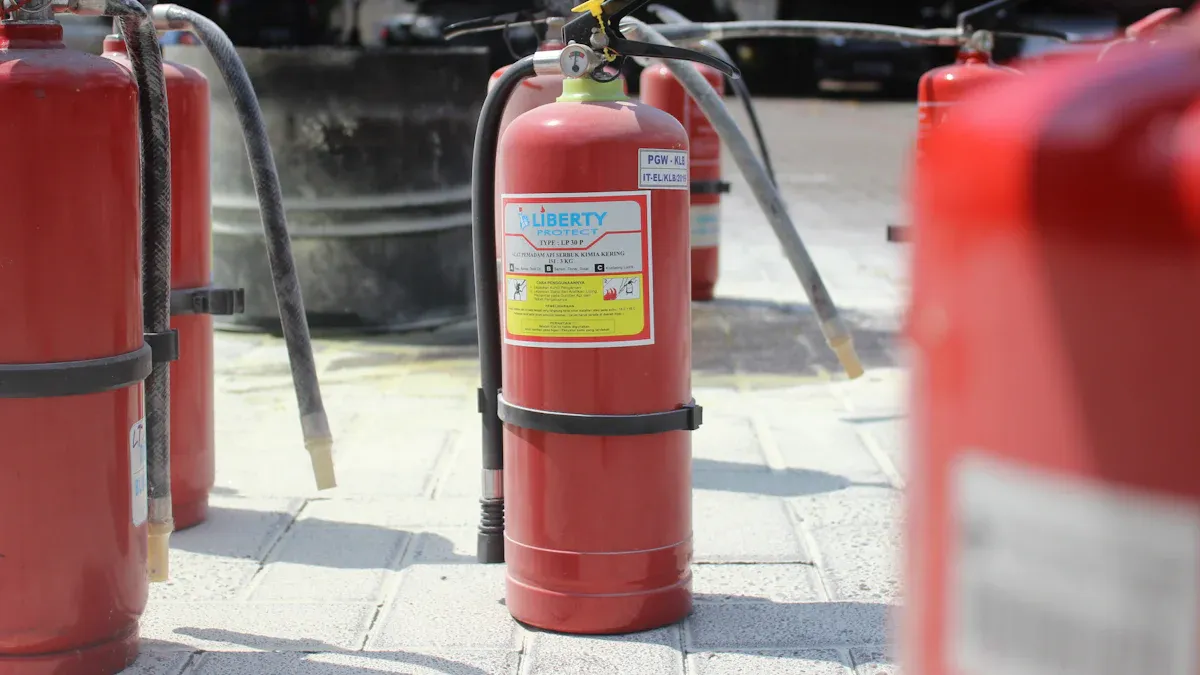
CO2 Fire Extinguishers provide safe, residue-free suppression for electrical fires. Their non-conductive nature protects sensitive equipment like those stored in a Fire Extinguisher Cabinet. Portable Foam Inductors and Dry Powder Extinguishers may leave residue. Incident data emphasizes safe handling procedures.
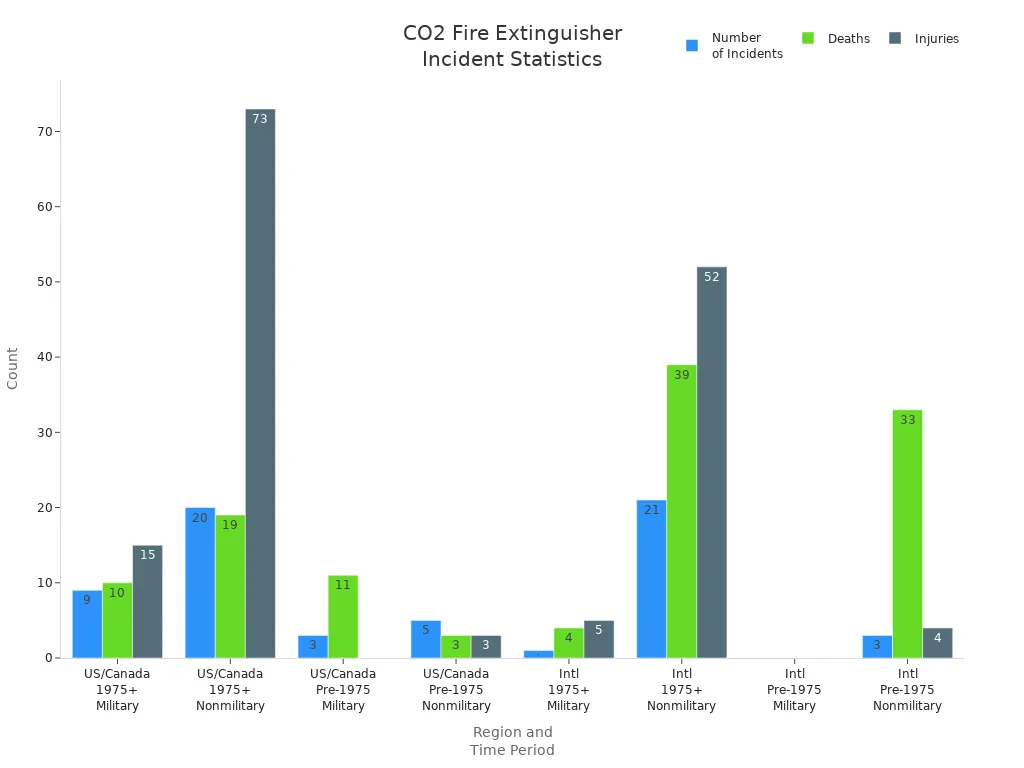
Key Takeaways
- CO2 fire extinguishers are safe for electrical fires because they do not conduct electricity and leave no residue, protecting sensitive equipment.
- Operators must use the PASS method and maintain proper distance and ventilation to ensure safe and effective fire suppression.
- Regular inspection, maintenance, and training help keep CO2 extinguishers ready and reduce risks in electrical hazard zones.
Why CO2 Fire Extinguishers Are Best for Electrical Hazard Zones
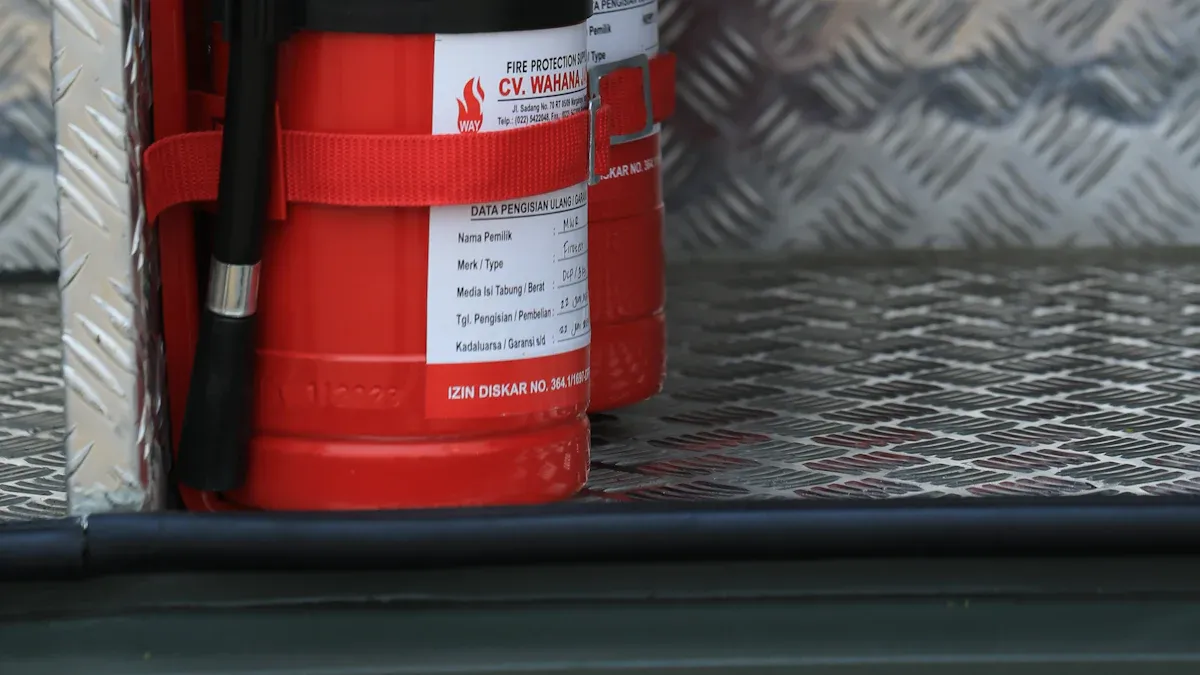
Non-Conductivity and Electrical Safety
CO2 Fire Extinguishers provide a high level of safety in electrical hazard zones. Carbon dioxide is a non-conductive gas, so it does not carry electricity. This property allows people to use these extinguishers on energized electrical equipment without risking electric shock.
- CO2 extinguishers work by displacing oxygen, which smothers the fire instead of using water or other agents that might conduct electricity.
- The horn nozzle design helps direct the gas safely onto the fire.
- These extinguishers are especially effective for Class C fires, which involve electrical equipment.
CO2 Fire Extinguishers are preferred in places like server rooms and construction sites because they minimize the risk of electrical shock and equipment damage.
No Residue on Electrical Equipment
Unlike dry chemical or foam extinguishers, CO2 Fire Extinguishers leave no residue after use. The carbon dioxide gas dissipates completely into the air.
This residue-free property protects sensitive electronics from corrosion or abrasion.
Minimal cleanup is needed, which helps prevent downtime and avoids costly repairs.
- Data centers, laboratories, and control rooms benefit from this feature.
- Powder extinguishers can leave behind corrosive dust, but CO2 does not.
Fast and Effective Fire Suppression
CO2 Fire Extinguishers act quickly to control electrical fires. They release high-pressure gas that rapidly lowers oxygen levels, stopping combustion in seconds.
Below is a table comparing discharge times:
| Extinguisher Type | Discharge Time (seconds) | Discharge Range (feet) |
|---|---|---|
| CO2 10 lb | ~11 | 3-8 |
| CO2 15 lb | ~14.5 | 3-8 |
| CO2 20 lb | ~19.2 | 3-8 |
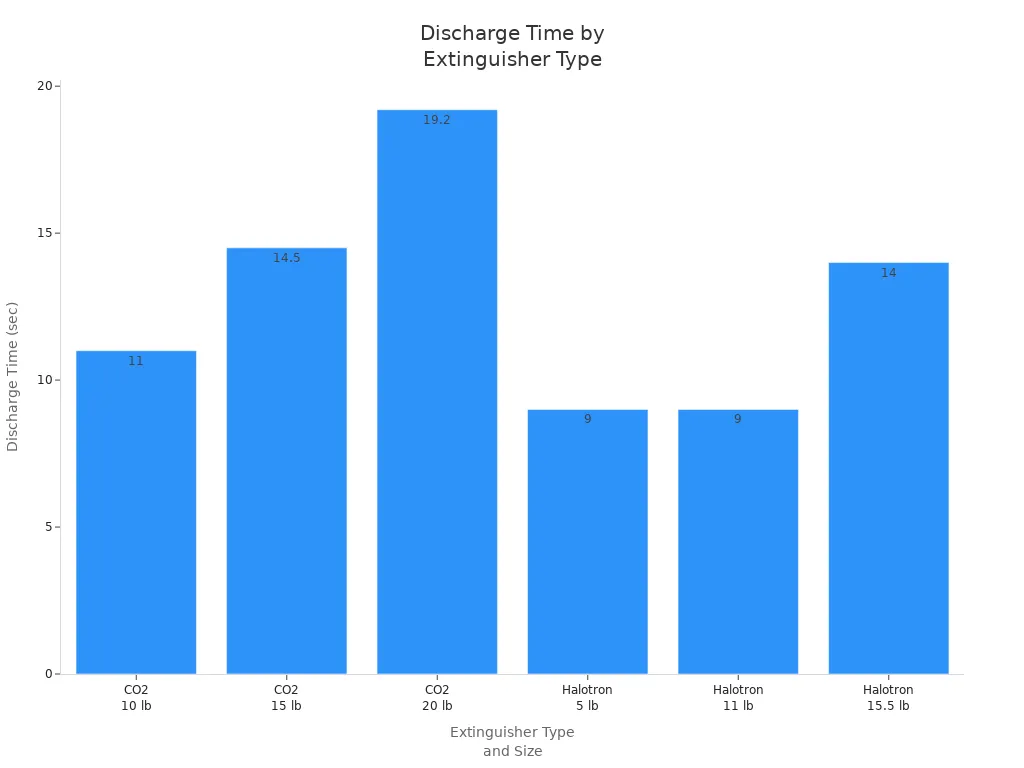
CO2 Fire Extinguishers provide rapid suppression without water damage or residue, making them ideal for protecting valuable electrical equipment.
Safe Operation of CO2 Fire Extinguishers in Electrical Hazard Zones
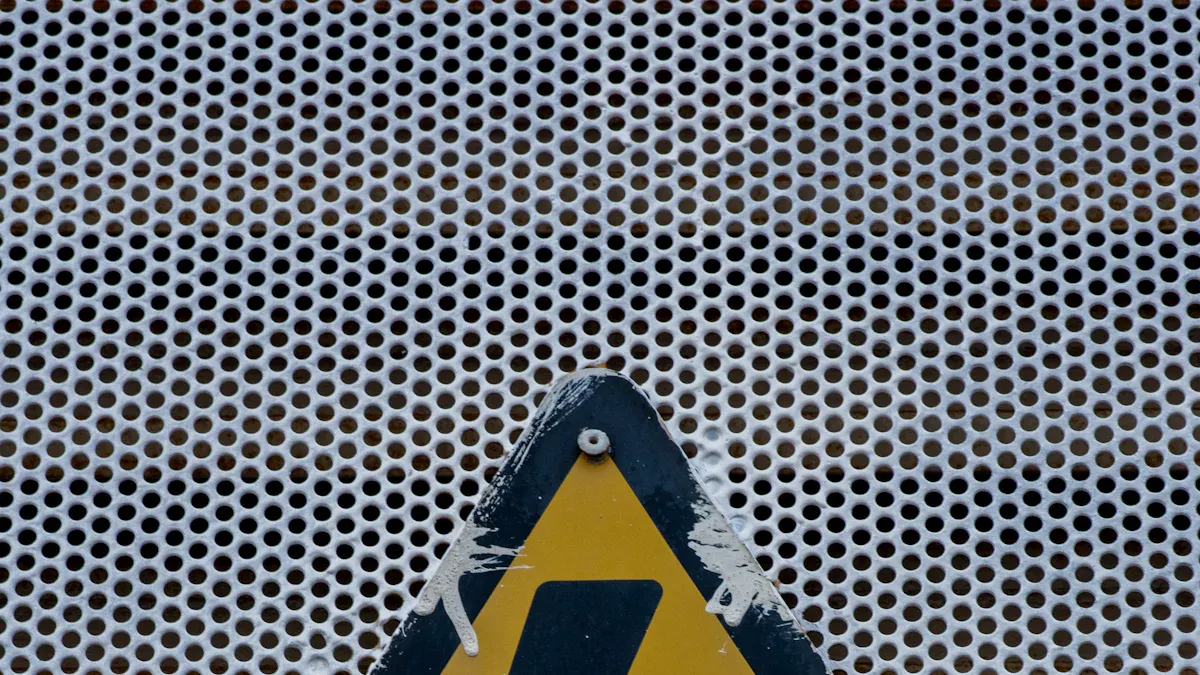
Assessing the Fire and Environment
Before using a CO2 Fire Extinguisher, operators must evaluate the fire and its surroundings. This assessment helps prevent unnecessary risks and ensures the extinguisher will work effectively. The following table outlines the recommended steps and considerations:
| Step/Consideration | Description |
|---|---|
| Extinguisher Size | Select a size that the user can handle safely and effectively. |
| Extinguisher Rating | Confirm the extinguisher is rated for electrical fires (Class C). |
| Fire Size and Manageability | Determine if the fire is small and controllable; evacuate if the fire is large or spreading fast. |
| Area Size | Use larger extinguishers for bigger spaces to ensure full coverage. |
| Use in Confined Spaces | Avoid using in small, enclosed areas due to risk of CO2 poisoning. |
| Signs to Evacuate | Watch for structural damage or rapid fire growth as signals to evacuate. |
| Ventilation | Ensure the area has proper ventilation to prevent oxygen displacement. |
| Manufacturer Guidelines | Always follow manufacturer instructions for safe use. |
| PASS Technique | Apply the Pull, Aim, Squeeze, Sweep method for effective operation. |
Tip: Operators should never attempt to fight a fire that is too large or spreading quickly. If there are signs of structural instability, such as warped doors or sagging ceilings, immediate evacuation is necessary.
Proper Operation Techniques
Operators must use the correct technique to maximize the effectiveness of CO2 Fire Extinguishers and minimize risk. The PASS method remains the industry standard:
- Pull the safety pin to unlock the extinguisher.
- Aim the nozzle at the base of the fire, not at the flames.
- Squeeze the handle to release the CO2.
- Sweep the nozzle from side to side, covering the fire area.
Personnel should activate audible and visual alarms before discharging CO2 to warn others in the area. Manual pull stations and abort switches allow operators to delay or stop discharge if people remain inside. Yuyao World Fire Fighting Equipment Factory recommends regular training on these procedures to ensure all staff can respond quickly and safely.
Note: Operators must comply with NFPA 12 standards, which cover system design, installation, testing, and evacuation protocols. These standards help protect both people and equipment.
Maintaining Safe Distance and Ventilation
Maintaining a safe distance from the fire and ensuring proper ventilation are critical for operator safety. CO2 can displace oxygen, creating a risk of suffocation, especially in enclosed spaces. Operators should:
- Stand at least 3 to 8 feet from the fire when discharging the extinguisher.
- Ensure the area is well-ventilated before and after use.
- Use CO2 sensors placed at head height (3 to 6 feet above the floor) to monitor gas levels.
- Keep CO2 concentrations below 1000 ppm to avoid hazardous exposure.
- Provide a minimum ventilation rate of 15 cfm per person in occupied spaces.
Warning: If CO2 sensors fail, ventilation systems must default to bringing in outside air to maintain safety. Multiple sensors may be needed in large or crowded areas to ensure accurate monitoring.
The CGA GC6.14 guideline emphasizes the importance of proper ventilation, gas detection, and signage to prevent health risks from CO2 exposure. Facilities must install and maintain these systems to comply with safety standards.
Personal Protective Equipment and Post-Use Checks
Operators should wear appropriate personal protective equipment (PPE) when using CO2 Fire Extinguishers. This includes:
- Insulated gloves to prevent cold burns from the discharge horn.
- Safety goggles to protect eyes from the cold gas and debris.
- Hearing protection if alarms are loud.
After extinguishing the fire, operators must:
- Check the area for signs of re-ignition.
- Ventilate the space thoroughly before allowing reentry.
- Measure CO2 levels at multiple heights to confirm safe air quality.
- Inspect the extinguisher and report any damage or discharge to maintenance personnel.
Yuyao World Fire Fighting Equipment Factory advises regular drills and equipment checks to ensure readiness and compliance with safety protocols.
CO2 Fire Extinguishers: Precautions, Limitations, and Common Mistakes
Avoiding Re-Ignition and Misuse
Operators must stay alert after extinguishing an electrical fire. Fires can reignite if heat or sparks remain. They should monitor the area for several minutes and check for hidden flames. Using CO2 Fire Extinguishers on the wrong type of fire, such as combustible metals or deep-seated fires, can lead to poor results. Staff should always match the extinguisher to the fire class and follow training protocols.
Tip: Always ventilate the area after use and never leave the scene until the fire is completely out.
Inappropriate Environments and Health Risks
Some environments are not safe for CO2 Fire Extinguishers. Operators should avoid using them in:
- Enclosed spaces like walk-in coolers, breweries, or laboratories
- Areas without proper ventilation
- Rooms where windows or vents remain closed
CO2 can displace oxygen, creating serious health risks. Symptoms of exposure include:
- Difficulty breathing or shortness of breath
- Headache, dizziness, or confusion
- Increased heart rate
- Loss of consciousness in severe cases
Operators should always ensure good airflow and use CO2 monitors when working in confined areas.
Regular Inspection and Maintenance
Proper inspection and maintenance keep extinguishers ready for emergencies. The following steps help maintain safety:
- Conduct monthly visual inspections for damage, pressure, and tamper seals.
- Schedule annual maintenance by certified technicians, including internal and external checks.
- Perform hydrostatic testing every five years to check for leaks or weaknesses.
- Keep accurate records and follow NFPA 10 and OSHA standards.
Routine checks ensure CO2 Fire Extinguishers work reliably in electrical hazard zones.
CO2 fire extinguishers offer reliable protection in electrical hazard zones when operators follow safety guidelines and perform regular inspections.
- Monthly checks and annual servicing keep equipment ready for emergencies.
- Ongoing training helps employees use the PASS technique and respond quickly.
Regular practice and compliance with fire codes improve workplace safety and reduce risks.
FAQ
Can CO2 fire extinguishers damage computers or electronics?
CO2 fire extinguishers do not leave residue. They protect electronics from corrosion or dust. Sensitive equipment stays safe after proper use.
What should operators do after using a CO2 extinguisher?
Operators should ventilate the area. They must check for re-ignition. They should monitor CO2 levels before allowing people to re-enter.
Are CO2 fire extinguishers safe for use in small rooms?
Operators should avoid using CO2 extinguishers in small, enclosed spaces. CO2 can displace oxygen and create a suffocation risk.
Post time: Jul-15-2025

